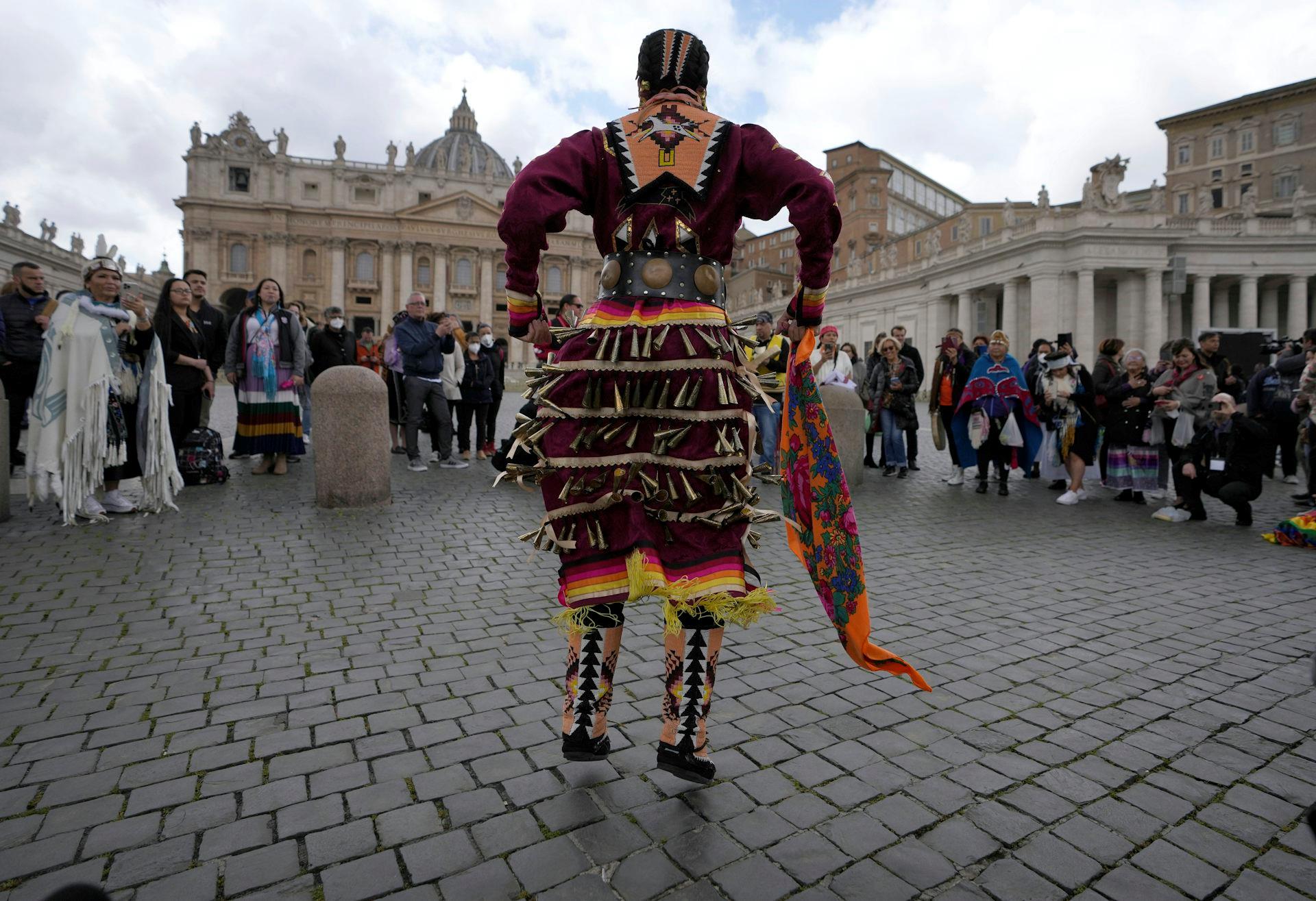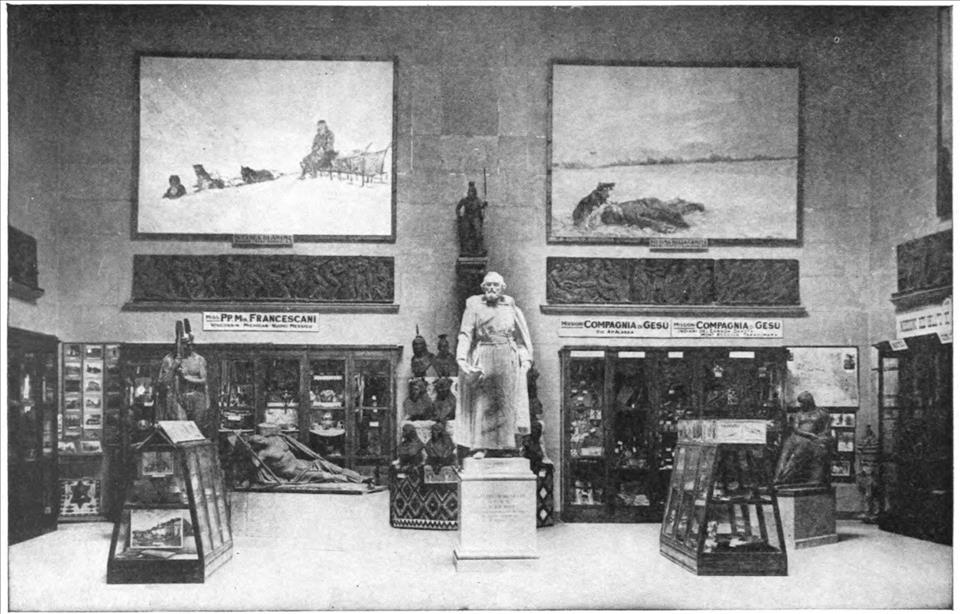
An Art Historian Looks At The Origins Of The Indigenous Arts Collection At The Vatican Museums
The papal narrative that these belongings are“gifts” needs correction. The Vatican says the artifacts are“part of the patrimony received on the occasion of the Vatican Missionary Exhibition (VME) of 1925.” However, as I document in my book Eternal Sovereigns: Indigenous Artists, Activists, and Travelers Reframing Rome the majority of the Indigenous belongings in the Vatican Museums were stolen from Indigenous communities during the 1920s and displayed at this exhibition.
The study divulges an important story, examining the history of the 1925 Vatican exhibit alongside destruction of Indigenous cultures, communities and lives through the Indian Act and residential schools in Canada, and genocidal activities by missionaries in partnership with the government carried out in residential schools. The book includes details of my encounters with artists, curators and archives.
As a scholar of art history and communication studies concerned with a broader anti-colonial approach to understanding Indigenous heritage, I use the terms“belongings,”“ancestral art” and“ancestors” instead of speaking of Indigenous artifacts at the Vatican.
My research aims to unpack the sovereignty of Indigenous art and ancestors held at the Vatican Museums. Currently I am tracing the life of Anthony Martin Fernando, an Aboriginal protester with Dharug ancestry. As I document in the book, Fernando handed leaflets to visitors outside the VME in 1925 about the ongoing genocide of First Peoples and the need to recognize Indigenous sovereignty.
Read more: Friday essay: crimes, redemption and rebellion – the truths told in 65,000 years of Australian art are essential for national healing
Indigenous communities, government officials, scholars and artists have advocated for the return of Indigenous ancestors from the Vatican Museums as part of wider calls for truth, reconciliation and justice.
A joint statement from the Vatican and CCCB said Pope Leo“desires that this gift represent a concrete sign of dialogue, respect and fraternity,” and the CCCB says it will“transfer these artifacts” to Indigenous organizations that will“ensure that the artifacts are reunited with their communities of origin.”

A dancer in St. Peter's Square at the Vatican in April 2022 during a visit of First Nations, Métis and Inuit delegates to Rome to meet with the late Pope Francis on calls for a papal apology for residential schools. (AP Photo/Alessandra Tarantino) Culture of conquest
Indigenous belongings from nations including Cree, Lakota, Anishinaabe, Nipissing, Kanien'kehá:ka, Wolastoqiyik and Kwakwaka'wakw have remained in the Anima Mundi collection without Indigenous care for 100 years.
Now some of them will be returned home.
As I discuss in my book, thousands of Indigenous ancestors were stolen from Indigenous communities by the Catholic Church. Beyond what the Vatican has now committed to repatriating, many more belongings also need to be returned home and brought back into Indigenous care and hands.
Promotional poster for the 1925 Vatican Missionary Exhibition. (Gloria Bell), Author provided (no reuse)
I uncovered documents about the 1925 Vatican Missionary Exhibition through a lengthy process of research in archives across Rome and Turtle Island (North America).
The 1925 exhibit was a kind of ground zero for residential schools in Canada, as it celebrated missionary labour following amendments to the Indian Act in 1920 that made attending residential schools compulsory for children between the ages of seven and 15.
This scholarship involved tracing the provenance of many Indigenous belongings and linking them with different missionary orders. It also probes religious imperialism that continues to this day in the form of the current museum display of Indigenous belongings.
The Vatican Museums now has an online database, not available even five years ago. This can be used to do research on Indigenous belongings held in its collections, in a step towards more transparency.
Read more: The Vatican just renounced a 500-year-old doctrine that justified colonial land theft... Now what? - Podcast
Origins of 'Anima Mundi'In December 1924, pope Pius XI opened the holy doors to the Vatican Missionary Exposition. Standing in the Hall of North America, one of the main exhibition spaces, he welcomed tourists and pilgrims to view First Nations, Métis and Inuit material, cultural and sacred belongings sent in especially for the exhibition.
The exhibition celebrated missionaries as noble and heroic labourers, but positioned Indigenous Peoples as needing redemption. The global exhibition, was unique in that it was the largest Catholic missionary exhibition of its time, competing with Protestant exhibitions in a race to convert souls.
Ticket to the 1925 Vatican Missionary Exhibition. (Gloria Bell), Author provided (no reuse)
Pope Pius XI decreed that everything that could be sent in from missions - including sacred and secular cultural belongings, Indigenous language materials and living human beings - should be included.
Before the exhibit, in 1923, The New York Times ran an Associated Press report that“one of the most attractive features would be 'Natives brought specially to Rome, showing the customs and modes of living.'”
One million visitors attended the exhibition, and more than 100,000 Indigenous belongings were sent in for the expo. About 40,000 belongings remain in the Vatican Museums and became part of the permanent collection that's now called Anima Mundi.
Not inadvertently, the 1925 exhibition was created like an adventure game where visitors could encounter wax models of Indigenous people, missionary children's games, cultural belongings and touch materials. Missionary orders including the Jesuits, Verbites, Grey Nuns, Oblates and Cappucins all sent displays.
Indigenous ancestors put on display included beaded octopus bags, sacred masks, Cree moccasins, ledger art, photographs, potlatch regalia and an Inuvialuit sealskin kayak.
Parallel removal of children from communitiesAt the same time, missionaries acting under the Indian Act were forcibly removing Indigenous children from their communities across Canada and the United States.
Drummers raise their arms as they sing and drum to begin a ceremony to mark the National Day for Truth and Reconciliation, at the site of the former St. Mary's Indian Residential School in Mission, B.C., on Sept. 30, 2022. THE CANADIAN PRESS/Darryl Dyck
Some missionaries sent materials made by these Indigenous children to the exhibit. Evidence of this includes photographs in the Indian Sentinel of Očhéthi Šakówiŋ (Sioux) children at residential schools, alongside missionaries' own commentary about material.
For example, Rev. Florentin Digman of St. Francis Mission, Rosebud Reservation of South Dakota, wrote in May 1925 in the summary of the photograph of young Očhéthi Šakówiŋ girls:
One of the most chilling finds in my archival research was uncovering drawings made by Indigenous children held in residential schools in British Columbia displayed at the 1925 VME. The language many missionaries used to describe these and other Indigenous belongings were“trophies of the pope.”
The 1925 exhibition created a visual reminder of the Vatican's celebration of Catholic conquest.
Read more: Looking for Indigenous history? 'Shekon Neechie' website recentres Indigenous perspectives
'Anima Mundi' exhibit todayAlthough the 1925 exhibition was a century ago, the same values of Indigenous erasure are present in current display techniques and the overall curatorial message.
In the Anima Mundi exhibit today, the curators don't address the genocide of Indigenous children during the colonial era by missionaries in partnership with the state. Indigenous artists' names, communities and languages are often not mentioned and Indigenous belongings are still described as gifts of the pope.
Pope Leo needs to acknowledge the harm caused by the patronizing and colonial narrative represented in Anima Mundi. The return of 62 Indigenous ancestors to Indigenous communities on Turtle Island is a first step, but much more needs to be done.

Legal Disclaimer:
MENAFN provides the
information “as is” without warranty of any kind. We do not accept
any responsibility or liability for the accuracy, content, images,
videos, licenses, completeness, legality, or reliability of the information
contained in this article. If you have any complaints or copyright
issues related to this article, kindly contact the provider above.


















Comments
No comment